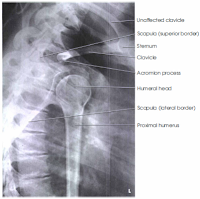LAWRENCE METHOD - Transthoracic Lateral View
Pathology Demonstrated:- Fracture and/or dislocations of the proximal humerus are demonstrated.
 |
| Upright : Lawrence Method (Transthoracic Lateral View) |
Technical Factors:
- IR size - 24 x 30 cm (10 x 12 inches), lengthwise
- Moving or stationary grid, vertical, CR to centerline
- 75 +- 5 kV range
- Minimum of 3 seconds exposure time with breathing technique (4 -5 seconds is desirable)
Shielding | Patient Position | Part Position
- Shield pelvic area.
- Perform radigraph with the patient in an erect or supine position. (The erect position is preferred and also may be more comfortable for the patient.) Place patient in lateral position with side of interest against IR. With patient supine, place grid lines vertically and center CR to centerline to prevent grid cutoff.
- Place affected arm at patient's side in neutral rotation; drop shoulder if possible.
- Raise opposite arm and place hand over top of head; elevate shoulder as much as possible to prevent superimposition of affected shoulder.
- Center surgical neck and center of IR to CR as projection through thorax.
- Ensure the thorax is in a true lateral position or has slight anterior rotation of unaffected shoulder to minimize superimposition of humerus by thoracic vertebrae.
 |
| Patient Supine | Lawrence Method (Transthoracic Lateral View) |
Cenral Ray | Colimation | Patient Respiration
- CR perpendicular to IR, directed through thorax to surgical neck (see note)
- Minimum SID of 40 inches (100 cm)
- Collimate on four sides of interest.
- Breathing technique is preferred if patient can cooperate. Patient should be asked to gently breathe short, shallow breaths without moving affected arm or shoulder. (This will best visualize proximal humerus by blurring out ribs and lung structures.)
- If patient is in too much pain to drop injured shoulder and elevate uninjured arm and shoulder high enough to prevent superimposition of shoulder, angle CR 10 degree to 15 degrees cephalad.
 |
| Transthoracic Latral View |
Radiographic Criteria:
Sructure Shown | Proper Position
- Lateral view of proximal half of the humerus and the glenohumeral joint should be visualized through the thorax without superimposition of the opposite shoulder.
- The outline of the shaft of the proximal humerus should be clearly visualized anterior to the thoracic vertebrae.
- The relationship of the humeral head and the glenoid cavity should be demonstrated.
 |
| Breathing Technique |
- Collimation should be visible on four sides to area of affected shoulder.
- CR and center of collimation field should be at the surgical neck of the affected humerus.
- Optimal density and contrast will demonstrate the entire outline of the humeral head and the proximal half of the humerus.
- Overlying ribs and lung markings should appear blurred because of breathing technique, but bony outlines of the humerus should appear sharp, indicating no motion of the arm during the exposure.







